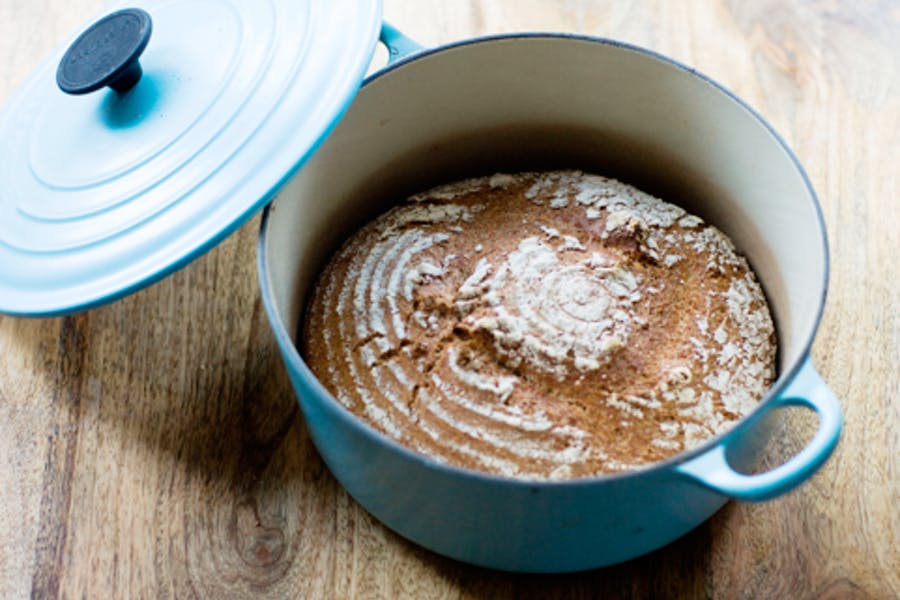Sometimes I worry that I’m flighty. And not in a charming, no one can tie me down, I’m-a-free-spirit sort of way. But rather skittish, unreliable, inconstant. When I feel that way, I come home and bake spelt bread.
Spelt bread is grounding. It is quick, physical work that you have to do with your hands. It doesn’t require skill, implements or fancy ingredients. I don’t need to set a timer or panic about precision. It transforms me into someone pragmatic, capable and resilient. Spelt bread turns me into the baker I wanted to be when I first started cooking.
I love sourdough. I think it’s magical, in the most literal sense of the word. It makes me feel like an alchemist or a witch standing over a cauldron, day by day watching the mixture slowly change from flour and water to something capable of making a loaf of bread and, finally, an actual loaf. But it is seriously slow-food. And it is serious. It requires care and tending. It is a literal flour baby, which sits in my fridge, and needs feeding every single day. The recipe I use for sourdough takes a week from start(er) to finish, and even when the starter is fully-fledged, there is a three day wait for the bread.
Spelt isn’t like that. If sourdough makes me feel like a (slightly nervous) magician, spelt bread makes me feel strong, powerful and deeply practical.
If sourdough makes me feel like a (slightly nervous) magician, spelt bread makes me feel strong, powerful and deeply practical.
Spelt bread proves very quickly compared to normal strong white, wholemeal, or rye bread flour. With a fair wind, you can start this bread when you get home from work and have it ready for supper. How’s that for practical and capable?
It’s a sturdy bread, that will support the heartiest of sandwiches, without being dense and claggy like pure rye bread. The crust is crisp, chewy and yielding all at the same time, and it slices like a dream. I don’t always add seeds to this loaf, but sometimes I do, and then I feel even more accomplished, nonchalantly chucking them in and kneading them through like an earth mother.
I bake this in a big casserole dish with a lid. When professional bakeries bake bread, they have high pressure steam sprays inside the oven to inject steam at appropriate points during the baking process. You can’t really replicate this in domestic ovens. You can bung ice in a tray at the base of the oven just before baking, which will create a blast of steam, but will also lower the temperature of your oven. But for rustic, rough and ready loaves like this, I use a casserole dish to prove or bake in: the lid traps the steam that evaporates from the dough and will give the thick, chewy crust that you’re looking for. You only need the lid on for about twenty minutes to achieve this.
It goes like this:
Super Speedy Spelt Bread
Makes: 1 loaf
Takes: 1 hour (including proving)
Bakes: Under 1 hour
500g spelt flour
300 ml water
5g yeast
10g salt
40 ml oil (vegetable, sunflower, even light olive)
Handful of sunflower seeds (optional)
Method
1. Mix the dry ingredients together by hand.
2. Add the water and oil, and bring the mixture together by hand until you have a cohesive lump of dough. Try and pick up as much of the material on the sides of the bowl as possible, as this will stop you getting dry crusty bits later.
3. Rub a little bit of oil onto your hand and smooth onto the orb of dough, cover the bowl with a clean tea towel or cling film and leave in a warm place for 20 minutes.
4. Flour a work surface and turn the dough out onto it. Knead the dough by pushing it away from you with the heel of your hand, and then folding it back on itself. Do this for a couple of minutes and the dough will be noticeably smoother and slightly springier. If you want to add seeds, do it now, and work them through the dough by continuing to knead until they are (roughly) evenly distributed.
• If you’re baking inside a loaf tin, put the dough into the loaf tin now, and leave to rise for about an hour.
• If you’re baking inside a casserole dish, and have a proving basket, flour the proving basket liberally and place the dough in it. Cover and leave for an hour.
• If you’re baking inside a casserole dish, and don’t have a proving basket, flour the base of the casserole dish, shape the dough into a cob shape, and place in the dish. Cover and leave for an hour.
5. Pre-heat your oven to 220°C. If you are proving your bread in a bannetone (proving basket) or loaf tin you can place your casserole dish in the oven to pre-heat. Don’t do this if there’s already a loaf inside it.
• If you’re proving inside a loaf tin, remove the casserole dish from the oven, slash the top of the loaf a couple of times with a sharp knife (I find this easiest to do with a floured bread knife), and carefully place the loaf tin in the casserole dish. Put the lid on the casserole dish and place in oven.
• If you’re proving in a proving basket, flour the base of the (hot!) casserole dish, turn your proving basket over the dish in one smooth movement, and let the bread fall heavily into the dish. Slash the top carefully, making sure you don’t burn your wrists. Put the lid on the casserole dish and place in oven.
• If you’re proving in the casserole dish, slash the top of the loaf with a sharp knife in whatever pattern you want. Put the lid on the casserole dish and place in oven.
6. After 20 minutes, remove the lid form the casserole dish, and turn the oven down to 200°C. Bake for another 20-30 minutes. The crust should be firm and a deep brown. Allow to cool completely before removing from the dish.
7. Ta Dah!
Icing on the Cake
This bread disappears somewhere between minutes to hours after it’s taken out of the dish, even in a household of two. I eat it with soup, or toasted with too much butter and too little marmite, eaten still standing over the toaster; I dunk it into soft boiled eggs, or pile it with teetering piles of salami and cornichons. It was made to be spread with thick honey or grilled with strong cheddar.






Comments